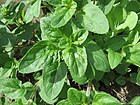Note: This is a project under development. The articles on this wiki are just being initiated and broadly incomplete. You can Help creating new pages.
Origanum vulgare - Origanum
Origanum is a genus of herbaceous perennials and shrubs in the family Lamiaceae and it is native to Europe, North Africa, and much of temperate Asia, where they are found in open or mountainous habitates. A few species also naturalized in scattered locations in North America and other regions.
Uses
Parts Used
Chemical Composition
Origanol B (2) along with ursolic acid (3), oleanolic acid (4), β-sitosterol (5), and triacontanol (6). Structures of the compound were established based on physical and spectral data (UV, IR, 1H and 13C NMR and mass). Origanol A (1) showed significant mushroom tyrosinase inhibition activity[1]
Common names
| Language | Common name |
|---|---|
| Kannada | Maruga |
| Hindi | Ban tulsi |
| Malayalam | Kattumaruva |
| Tamil | |
| Telugu | Mridumaruvamu |
| Marathi | NA |
| Gujarathi | NA |
| Punjabi | NA |
| Kashmiri | NA |
| Sanskrit | Maruvaka |
| English | Oregano, Wild marjoram |
Properties
Reference: Dravya - Substance, Rasa - Taste, Guna - Qualities, Veerya - Potency, Vipaka - Post-digesion effect, Karma - Pharmacological activity, Prabhava - Therepeutics.
Dravya
Rasa
Tikta (Bitter), Kashaya (Astringent)
Guna
Laghu (Light), Ruksha (Dry), Tikshna (Sharp)
Veerya
Ushna (Hot)
Vipaka
Katu (Pungent)
Karma
Kapha, Vata
Prabhava
Habit
Identification
Leaf
| Kind | Shape | Feature |
|---|---|---|
| Simple | lobed | here are two leaves per node along the stem |
Flower
| Type | Size | Color and composition | Stamen | More information |
|---|---|---|---|---|
| Unisexual | 2-4cm long | Blue, purple, pink, red | 5 | there is only one way to evenly divide the flower |
Fruit
| Type | Size | Mass | Appearance | Seeds | More information |
|---|---|---|---|---|---|
| general | 7–10 mm | the fruit is dry but does not split open when ripe | many | {{{6}}} |
Other features
List of Ayurvedic medicine in which the herb is used
Where to get the saplings
Mode of Propagation
How to plant/cultivate
Landscape Uses:Border, Container, Ground cover, Rock garden, Seashore. Requires a rather dry, warm, well-drained soil in full sun, but is not fussy as to soil type, thriving on chalk[3]
Commonly seen growing in areas
Photo Gallery
References
External Links
- Ayurvedic Herbs known to be helpful to treat Headache
- Ayurvedic Herbs known to be helpful to treat Catarrh
- Ayurvedic Herbs known to be helpful to treat Cold
- Ayurvedic Herbs known to be helpful to treat Flu
- Ayurvedic Herbs known to be helpful to treat Nasal congestion
- Ayurvedic Herbs known to be helpful to treat Bronchitis
- Ayurvedic Herbs known to be helpful to treat Asthma
- Ayurvedic Herbs known to be helpful to treat Cough
- Ayurvedic Herbs known to be helpful to treat Sore throats
- Herbs with Leaves used in medicine
- Herbs with Whole herb used in medicine
- Herbs with common name in Kannada
- Herbs with common name in Hindi
- Herbs with common name in Malayalam
- Herbs with common name in Telugu
- Herbs with common name in Sanskrit
- Herbs with common name in English
- Habit - Herb
- Index of Plants which can be propagated by Seeds
- Index of Plants which can be propagated by Cuttings
- Herbs that are commonly seen in the region of Tall grasslands
- Herbs that are commonly seen in the region of Meadows
- Herbs that are commonly seen in the region of Borders of forests and fields
- Herbs
- Ayurvedic herbs that don't have seed photos
- Lamiaceae








